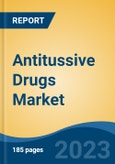Speak directly to the analyst to clarify any post sales queries you may have.
10% Free customizationThis report comes with 10% free customization, enabling you to add data that meets your specific business needs.
This market benefits from strong consumer demand for both over-the-counter (OTC) and prescription-based antitussive medications, with major contributions from leading pharmaceutical corporations and emerging industry players. Ongoing research and development (R&D) efforts, alongside advancements in drug formulations, are shaping competitive dynamics and fostering product innovation.
Key Market Drivers
Rising Prevalence of Respiratory Diseases
The rising prevalence of respiratory diseases is one of the most significant drivers fueling the expansion of the Global Antitussive Drugs Market. With an increasing number of people experiencing respiratory illnesses, the demand for cough suppressants and related medications is witnessing steady growth. Each year, chronic obstructive pulmonary disease (COPD) claims over 3 million lives, yet it remains significantly underprioritized in global healthcare discussions. Affecting more than 380 million people worldwide, COPD is the fourth leading cause of death, imposing a severe economic and healthcare burden.Despite its widespread impact on patients, caregivers, and healthcare systems, the disease continues to receive disproportionately low attention and funding compared to other major noncommunicable diseases. Chronic and acute respiratory diseases, such as chronic obstructive pulmonary disease (COPD), asthma, bronchitis, pneumonia, tuberculosis (TB), and post-viral cough syndromes, are becoming more prevalent worldwide. In 2023, tuberculosis (TB) affected an estimated 10.8 million people globally, including 6.0 million men, 3.6 million women, and 1.3 million children, highlighting its widespread impact across demographics. Present in every country and affecting all age groups, TB continues to pose a significant public health challenge. These conditions often manifest with persistent coughing, requiring effective antitussive (cough suppressant) treatments.
Key Market Challenges
Regulatory Hurdles and Stringent Approvals
One of the primary challenges in the antitussive drugs market is the rigorous regulatory environment governing pharmaceuticals. To ensure safety and efficacy, regulatory agencies such as the FDA (U.S. Food and Drug Administration) and the EMA (European Medicines Agency) impose stringent approval processes for new antitussive drugs.Developing and bringing a new antitussive drug to market involves extensive clinical trials, data submission, and regulatory reviews. The process is time-consuming and costly, with no guarantee of approval. Companies may face delays, increased development costs, or even the rejection of their drug candidates, impacting market entry.
Key Market Trends
Shift Towards Non-Opioid and Non-Codeine Formulations
One of the prominent trends in the antitussive drugs market is the increasing preference for non-opioid and non-codeine formulations. This shift is primarily driven by concerns related to the addictive potential and side effects associated with opioid-based antitussive drugs.Regulatory Scrutiny: Regulatory agencies like the FDA have imposed stricter controls and monitoring of opioid-based medications due to their potential for abuse and addiction. This has led to a reduced appetite among healthcare providers to prescribe such drugs. Patient Safety: Patient safety and minimizing the risk of opioid misuse have become paramount concerns. Non-opioid alternatives are seen as safer options for managing coughing, especially in pediatric and vulnerable patient populations.
Advances in pharmaceutical research have led to the development of non-opioid antitussive medications that offer comparable efficacy in suppressing coughing without the risk of opioid-related complications. This has fueled the market demand for non-opioid alternatives.
Key Market Players
- Teva Pharmaceutical Industries Ltd.
- Intas Pharmaceuticals Ltd.
- Bayer AG
- Ipca Laboratories Ltd.
- F. Hoffmann-La Roche Ltd.
- Hikma Pharmaceuticals PLC
- Unique Pharmaceuticals Limited
- Cipla Inc.
- Viatris Inc.
- Aurobindo Pharma
Report Scope:
In this report, the Global Antitussive Drugs Market has been segmented into the following categories, in addition to the industry trends which have also been detailed below:Antitussive Drugs Market, By Drug Class:
- Peripherally Acting Drugs
- Centrally Acting Drugs
- Others
Antitussive Drugs Market, By Route of Administration:
- Inhalational
- Oral
- Others
Antitussive Drugs Market, By Age Group:
- Geriatric
- Pediatric
- Adult
Antitussive Drugs Market, By End-User:
- Homecare
- Hospitals & Specialty Clinics
- Others
Antitussive Drugs Market, By Region:
- North America
- United States
- Canada
- Mexico
- Europe
- France
- United Kingdom
- Italy
- Germany
- Spain
- Asia-Pacific
- China
- India
- Japan
- Australia
- South Korea
- South America
- Brazil
- Argentina
- Colombia
- Middle East & Africa
- South Africa
- Saudi Arabia
- UAE
Competitive Landscape
Company Profiles: Detailed analysis of the major companies present in the Global Antitussive Drugs Market.Available Customizations:
With the given market data, the publisher offers customizations according to a company's specific needs. The following customization options are available for the report.Company Information
- Detailed analysis and profiling of additional market players (up to five).
This product will be delivered within 1-3 business days.
Table of Contents
Companies Mentioned
- Teva Pharmaceutical Industries Ltd.
- Intas Pharmaceuticals Ltd.
- Bayer AG
- Ipca Laboratories Ltd.
- F. Hoffmann-La Roche Ltd.
- Hikma Pharmaceuticals PLC
- Unique Pharmaceuticals Limited
- Cipla Inc.
- Viatris Inc.
- Aurobindo Pharma
Table Information
| Report Attribute | Details |
|---|---|
| No. of Pages | 180 |
| Published | April 2025 |
| Forecast Period | 2024 - 2030 |
| Estimated Market Value ( USD | $ 1.6 Billion |
| Forecasted Market Value ( USD | $ 2.17 Billion |
| Compound Annual Growth Rate | 5.2% |
| Regions Covered | Global |
| No. of Companies Mentioned | 10 |









